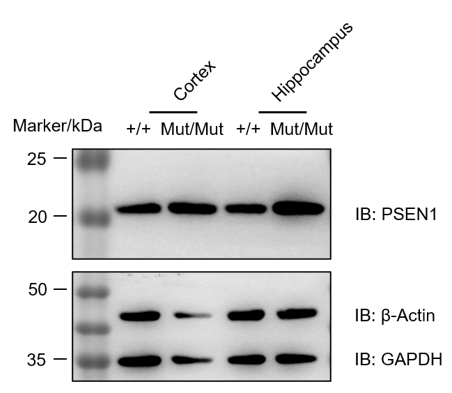


C57BL/6JNifdc-Psen1tm1Bcgen /Bcgen • 112977
| Product name | B-PSEN1*M146L*E120K mice |
|---|---|
| Catalog number | 112977 |
| Strain name | C57BL/6JNifdc-Psen1tm1Bcgen /Bcgen |
| Strain background | C57BL/6JNifdc |
| NCBI gene ID | 5663 |
| Aliases | AD3, FAD, PS1, PS-1, S182, CMD1U, PSNL1, ACNINV3 |
Gene targeting strategy for B-Psen1*P117L mice. The 120 and 146 amino acids Glu and Met of mouse Psen1 was mutated as Lys and Leu in B-Psen1*M146L*E120K mice.

Psen1 mRNA expression in wild-type C57BL/6J mice and homozygous B-Psen1*M146L*E120K mice by RT-PCR. Brain RNA were isolated from wild-type C57BL/6J mice (+/+) and homozygous B-Psen1*M146L*E120K mice (Mut/Mut), then cDNA libraries were synthesized by reverse transcription, followed by PCR with mouse Psen1 primers. Mouse Psen1 mRNA was detectable in wild-type C57BL/6J and homozygous mice. And the point mutations were confirmed via Sanger Sequencing.

Western blot analysis of PSEN1 protein expression in homozygous B-Psen1*M146L*E120K mice. Cortex and hippocampus lysates were collected from wild-type C57BL/6J mice (+/+) and homozygous B-Psen1*M146L*E120K mice (Mut/Mut), and then analyzed by western blot with anti-PSEN1 antibody (CST, #5643). 40 μg total proteins were loaded for western blotting analysis. PSEN1 was detected in cortex and hippocampus both in wild-type and homozygous B-Psen1*M146L*E120K mice.